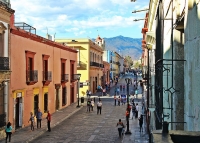
Oaxaca (pronounced wah-HA-kah) is a city developed over three centuries of colonisation. This influence is visible in the stunning architecture of the buildings, a solid style adapted from European methods to stand up to occasional earthquakes. The buildings are distinctively green, made of a particular stone mined in local quarries, and give Oaxaca its nickname, The Green Antequera.
In 1987, Oaxaca was declared a UNESCO World Heritage Site in recognition of its treasure of historic buildings and monuments. The city also offers a number of museums in town worth visiting, including those dedicated to local history, art ranging from ancient to contemporary times, railroads, stamps, and prominent citizens like former President of Mexico Benito Juarez. Oaxaca is also near the archaeological site of Monte Alban, site of one of the earliest cities of Mesoamerica dating back to 500 BC.
Oaxaca is known as the culinary capital of Mexico, and its gastronomic traditions go back to the Mayan civilisation. The street food is excellent, and often better than what is available in the more cosmopolitan fine dining establishments. Local specialties include spicy molesauces, chapulines(fried grasshoppers with chilli), and tlayudes(corn tortillas piled with meat and vegetable fillings). However, the real specialty of Oaxaca is chocolate. The heart of chocolate production in Mexico, some say Oaxaca was where the treat was invented centuries ago by ancient Mesoamericans. Visitors are spoiled for choice with restaurants, cafes and factories all offering mouth-watering options, but the town's specialty is its hot cocoa. Visitors also have the opportunity to take a chocolate-making class and learn to make their own treats through traditional methods.
Oaxaca is also known for its festivals, including the large Day of the Dead celebration each October, which lasts for three days. One of the most unique celebrations is the Night of the Radishes, held just before Christmas each year and featuring the distinctive red and white root carved into nativity scenes and other artistic creations.
Deep in the south of Mexico, Oaxaca is in one of the country's poorest areas and tourism development is not as sophisticated as that of the more popular destinations. However, a holiday in Oaxaca allows visitors to experience a more authentic side of Mexico that most tourists do not see.

Travel Guide powered by Word Travels, copyright © 2023 Globe Media Ltd. By its very nature information in this travel guide is subject to change at short notice and travellers are urged to verify information on which they're relying with the relevant authorities. Neither Globe Media Ltd nor Travel Vogue can accept any responsibility for any loss or inconvenience to any person as a result of information contained above.